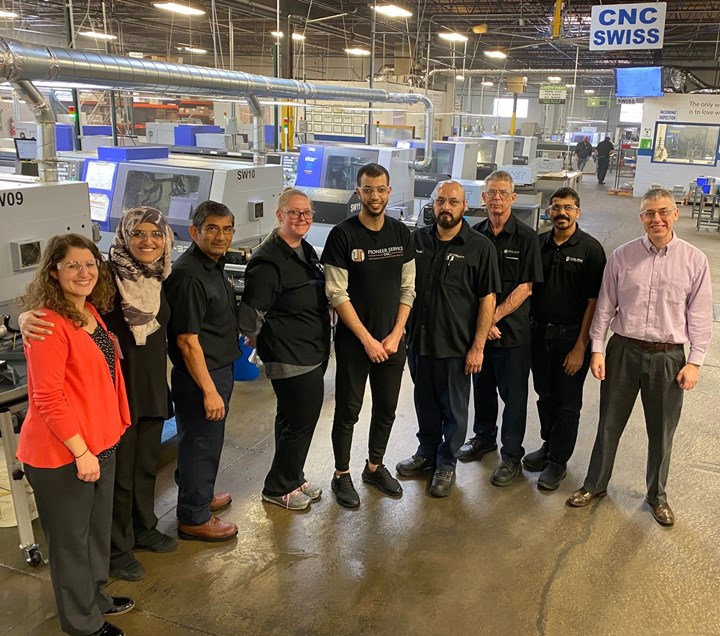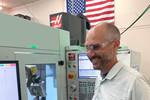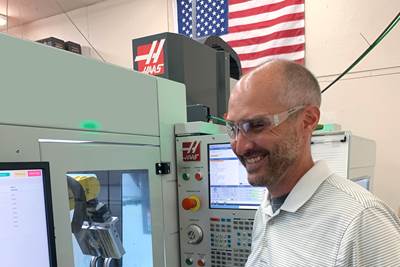MMS Is Back on the Shop Floor, But There Are Differences
Modern Machine Shop editors visit machining facilities to report stories. We are now more mindful than ever that the chance for this visit is a privilege. Meanwhile, what we are there to report has changed.

In this January 2020 photo, Modern Machine Shop senior editor Emily Probst (far left) and Editor-in-Chief Peter Zelinski (far right) pose for a photo with Pioneer Services Inc. personnel during an #ontheshopfloor visit.
We are back! Back out in the field, that is — back to visiting machine shops. COVID severely curtailed our travels for quite some time. But in our recent reporting on the machining facilities chosen as this year’s Top Shops honorees, all our articles on the winning facilities (in the categories of Machining Technology; Shopfloor Processes and Practices; Business Strategies and Performance; and Human Resources) were written from in-person visits to those shops.
I want to tell you, this feels great. I never imagined we would come to a long period of limiting our travel to shops. The “shop visit,” as we call it, is core to the way we do Modern Machine Shop — we take the time to visit the operations we report on. There are multiple reasons for this. We learn far more, and can report a more comprehensive story, if we visit the site in person rather than relying on a phone or video call. Plus, getting out to see how machining is done, and to learn from the people who are doing it, is perhaps the most rewarding and gratifying aspect of writing for MMS.

The #ontheshopfloor hashtag marked MMS’s shop visits prior to the pandemic.
Prior to 2020 and up until the COVID lockdowns, we were in the habit of promoting and celebrating our shop visits by posting photos of the encounter in social media with the hashtag “#ontheshopfloor.” Now, we face a question. It seems like question about a tiny matter, but it is not tiny at all, because the question hints at how the world has changed. Namely: Should we bring back the hashtag?
When COVID arrived, the hashtag certainly had to stop. It did not apply anymore. During the pandemic, we largely were not visiting machining facilities, and on the occasions when we did, the visit was built on careful attention to protocols around virus safety. Trumpeting the visit in social media would have been contrary to the guarded spirit of the encounter.
Now, things have opened up — except they haven’t. The guarded spirit is still with us, even though the COVID vaccines have brought freedom. As I write these words, the delta variant is in the news, and it is unclear to what extent its advance might lead to a resumption of 2020’s habits of isolation.
Which suggests part of the answer I find to the question about the hashtag. Should we bring it back, celebrating our shop visits? I believe no. That habit of showing off our travels, that flourish in social media, was a device for an earlier time, and not the right banner under which to proceed through the world today. We will still base our reporting and our original writing on the effort we make to visit, see and understand our readers’ operations. That much remains core. But when I explore the sense that the hashtag is not quite right anymore, I find two reasons for coming to this opinion, only one of which relates to public health:
1. The pandemic is not over. Its advance continues in other countries, and it has made enough of a resurgence in the U.S. to at least raise caution. Yet even in the absence of the latest variant, some level of attention to the lingering presence of COVID and transmissible illness in general is apt to remain part of our lives for years to come. Recognizing this heightens our awareness of the privilege we enjoy when a manufacturer reading MMS hosts us in their facility. The shop is under no obligation to have us as a guest, and we respect the greater obligation that company has to its employees, along with its prerogative to follow any policy it wants regarding visitors and exposure. Right now, most businesses are leaning into the freedom vaccination has provided, but not all are doing so and not all to the same extent. Therefore, to fly a banner in social media implying visitors are welcome potentially undervalues the privilege we have been given in being allowed to visit.
2. Mostly unrelated to the pandemic, the pandemic’s interruption to our deeper interactions with shops has allowed us to gage the progress of another, ongoing change that affects how we think about our articles. Namely: The story is not as extensively “on the shop floor” anymore. That is, the story we are apt to find in a machining business, the story we are there to cover, is less likely today to be exclusively about process and technology, the elements on the shop floor. Of course, process and technology are what shops invest in to advance; they are how shops do their work and how they increase their capability. For these reasons, the products, processes and technology shops use obviously will remain foundational. But significantly, technology has gotten easier to apply. Much of the advance of manufacturing technology in the last decade has aimed toward this benefit: ease of use. As a result, technology, in the form of what equipment to buy and how to use it well, does not loom as large as it once did in what a shop might consider its pressing struggles. The advance of machining businesses now increasingly entails changes in organization, culture and system — often coupled with changes from the top as the nature of shop ownership changes. The compelling stories now, the stories within the machining businesses we serve, more often take place throughout the enterprise, not necessarily so predominantly on the shop floor.
The post-COVID or post-2020 world is not a return to normal. That is because progress through struggle never offers a true return, and because the baseline for normal has never held steady. We all probably knew it would be this way: What we did in the past only partially applies to the present, because what we did then had its own moment in time. I don’t know what the right hashtag is for our efforts today. I will welcome it if we discover we have sobered enough and quieted enough that hashtags matter less. For now, we are visiting shops again, meeting readers there, spending time learning about their work and (dare I say it) shaking hands. This much all feels right, and good, and I am happy to discover that this much of how we have always done our work is still the right way to proceed.
Read Next
5 Reasons Why Machine Shop Ownership Is Changing
Mergers, acquisitions and other ownership changes are an effect of Boomer-age shop owners retiring, but only in part. Also important: The way we think about machining has changed.
Read MoreThe Cut Scene: The Finer Details of Large-Format Machining
Small details and features can have an outsized impact on large parts, such as Barbco’s collapsible utility drill head.
Read More3 Mistakes That Cause CNC Programs to Fail
Despite enhancements to manufacturing technology, there are still issues today that can cause programs to fail. These failures can cause lost time, scrapped parts, damaged machines and even injured operators.
Read More
.jpg;width=70;height=70;mode=crop)









.png;maxWidth=300;quality=90)












